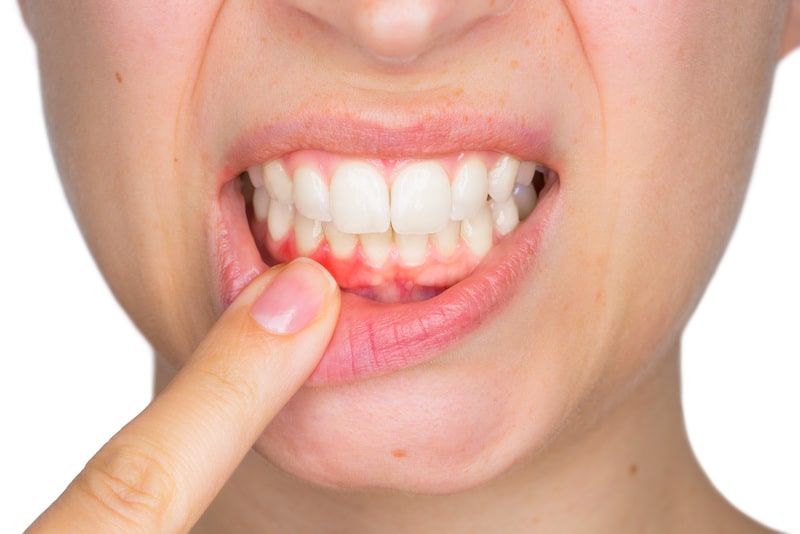The 5 Stages of Gum Disease: Where Do You Stand?
4 Minute Read:
Advanced periodontal disease doesn’t happen overnight, and anyone seeing their dentist regularly has a chance to prevent mild gum disease (gingivitis) from advancing to periodontitis.

If you haven’t visited a dentist in the last six months and are noticing any signs of early gum disease, get dental care as soon as possible.
Assessing Your Gum Health
Take a look at the following five stages of periodontal disease to help figure out how healthy your gums are:
- Poor oral health – A less than adequate oral hygiene routine is always the first step and the surest way to develop gum disease. If you are not brushing twice and flossing once daily, you are risking more than just your oral health. Many credible studies have proven a link between gum disease and overall well-being.
- Gingivitis – This condition is the earliest form of gum disease with signs including red or swollen gums that bleed. If you see blood when you brush your teeth, you are more than likely to have gingivitis. Gingivitis does not cause significant discomfort.
- Early periodontitis – In addition to swollen, bleeding gums, bad breath, sensitive teeth, pain when chewing, and receding gums all indicate the first stage of periodontitis. At this point, the underlying bone is being attacked by bacteria and the body’s own response to this infection.
- Moderate periodontitis – Symptoms increase with more swelling, pain, and periodontal pockets develop, attracting food, plaque, and more bacteria to accumulate. Teeth become loose, and bone deteriorates at a faster rate.
- Advanced periodontitis – At this stage, expect severe infection that spreads beneath the gums, tooth loss leading to abscesses, and increasing discomfort.
Which Periodontal Treatments Are Best for Your Condition?
Non-surgical options for gingivitis and mild to moderate forms of periodontitis:
- Deep cleaning – This is a thorough process including scaling and root planing to clear plaque and tartar from beneath the gum line. Tooth roots are smoothed to prepare the gum tissue for healing and reattachment to teeth. Antibiotics may also be necessary.
- Local antimicrobials – A substance that prevents bacteria from spreading is applied directly into any existing periodontal pocket to reduce or eliminate bacteria.
- Systemic antibiotics – An oral antibiotic is often prescribed after a deep cleaning to fight bacterial infection in the mouth.
- Periodontal disease maintenance – Maintaining your progress after your initial deep cleaning involves a combination of self-care and more frequent visits to your dentist. You will be given instructions on how to properly care for your teeth and gums and bad habits to avoid. Without vigilant attention, periodontal disease is likely to recur.
You may start with periodontal maintenance every three months. As the dentist sees positive results from your home care and regular scaling and root planing, you may be able to reduce these visits to every six months.
These surgical treatments are appropriate for cases of advanced cases of periodontitis that have resisted non-surgical procedures:
- Osseous surgery (pocket reduction) – This simple surgical process removes tartar and bacteria from tooth roots and reduces the pockets formed due to periodontal disease. This procedure involves cleaning the roots and reshaping the bone around the affected teeth.
- Soft tissue grafts – This technique is used in treating receding gums to defend against infiltrating oral bacteria and address the cosmetic consequences of periodontal disease. A thin piece of tissue obtained from the roof of your mouth is placed around the base of the tooth to restore damaged gum areas.
- Regenerative dental procedures – When bone degeneration results from advanced gum disease, guided tissue (bone) regeneration can help restore the affected jaw area, increasing its ability to secure remaining teeth or prepare the bone for dental implants. During the procedure, areas of deteriorated bone are cleaned, and a bone graft is placed. A special “regenerative” membrane is positioned between the soft tissue and treated bone, allowing the bone to grow and become healthier.
Want to Learn More About Your Gum Disease Treatment Options In Beverly Hills, CA?
Dr. Afshin Salamati is a well-respected periodontist in Beverly Hills, California, specializing in advanced gum disease care. Providing both traditional and regenerative treatments, Dr. Salamati may combine these methods to meet the unique needs of his patients.
If you suspect that you or a loved one has gum disease, regardless of which stage, don’t delay; call us today at (424) 379-3456.
